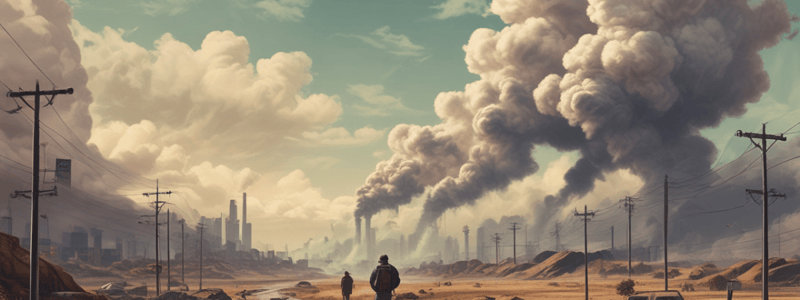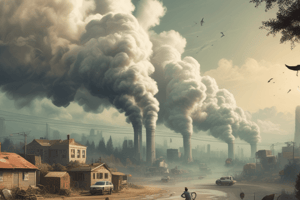Podcast
Questions and Answers
What is a major health effect of exposure to high levels of nitrogen oxides?
What is a major health effect of exposure to high levels of nitrogen oxides?
- Improving lung function
- Reducing oxygenation of body tissues (correct)
- Strengthening immune system
- Slowing down heart rate
What is the primary source of nitrogen oxides in cities?
What is the primary source of nitrogen oxides in cities?
- Industrial processes
- Agricultural activities
- Waste management
- Traffic emissions (correct)
What is formed in large concentrations in cities due to the chemical reaction between nitrogen oxides and volatile organic compounds?
What is formed in large concentrations in cities due to the chemical reaction between nitrogen oxides and volatile organic compounds?
- Sulfur dioxide
- Ozone (correct)
- Carbon monoxide
- Particulate Matter
What is a health effect of exposure to high concentrations of ozone?
What is a health effect of exposure to high concentrations of ozone?
What are the main components of the set of suspended particles that pollute the air?
What are the main components of the set of suspended particles that pollute the air?
What is a major source of lead emissions in the atmosphere?
What is a major source of lead emissions in the atmosphere?
What is a major environmental concern about lead?
What is a major environmental concern about lead?
What is the primary form of lead in the atmosphere?
What is the primary form of lead in the atmosphere?
What is a health effect of long-term exposure to suspended particles in the air?
What is a health effect of long-term exposure to suspended particles in the air?
What happens when suspended particles appear together with other air pollutants?
What happens when suspended particles appear together with other air pollutants?
Flashcards
Air Pollution
Air Pollution
Presence of harmful substances or energy in the atmosphere, impacting living beings and the environment.
Clean Air Act
Clean Air Act
Federal law to reduce air pollution, creating the EPA to enforce it.
EPA
EPA
The Environmental Protection Agency, an agency to enforce air quality standards.
Air Quality Index (AQI)
Air Quality Index (AQI)
Signup and view all the flashcards
Primary Pollutant
Primary Pollutant
Signup and view all the flashcards
Secondary Pollutant
Secondary Pollutant
Signup and view all the flashcards
Carbon Monoxide (CO)
Carbon Monoxide (CO)
Signup and view all the flashcards
Particulate Matter (PM)
Particulate Matter (PM)
Signup and view all the flashcards
Industry
Industry
Signup and view all the flashcards
AQI Categories
AQI Categories
Signup and view all the flashcards
Study Notes
Air Pollution
- Air pollution is the presence of materials or forms of energy in the atmosphere that can pose a risk, damage, or nuisance to living beings.
- Direct consequences of air pollution include the development of diseases and conditions in humans and biodiversity, as well as the loss of visibility or appearance of unpleasant odors in areas of large, concentrated populations.
The Clean Air Act
- The Clean Air Act of 1970 was a comprehensive federal response to fight and reduce air pollution.
- The EPA (Environmental Protection Agency) was created in 1970 to execute the Clean Air Act.
- The EPA establishes limits on certain air pollutants and gives authority to limit emissions of air pollutants from sources such as chemical plants, utilities, and steel mills.
- Each state or tribe may have more specific laws concerning air pollution, but may not have lower limits than those established by the EPA.
Air Quality Index (AQI)
- The EPA created the Air Quality Index (AQI) to provide information about local air quality, health problems for different levels of air pollution, and how people can protect their health when pollutants reach unhealthy levels.
- The AQI is a scale that ranges from 0 to more than 300, where 0 is a healthy air quality and more than 300 means hazardous air quality conditions.
- There are six air quality categories, each labeled by a different color:
- Green: Good (0-50) - Air quality is satisfactory, and air pollution poses little or no risk.
- Yellow: Moderate (51-100) - Air quality is acceptable, but may pose a risk for some people.
- Orange: Unhealthy for Sensitive Groups (101-150) - Members of sensitive groups may experience health effects.
- Red: Unhealthy (151-200) - Some members of the general public may experience health effects.
- Purple: Very Unhealthy (201-300) - Health alert: The risk of health effects is increased for everyone.
- Maroon: Hazardous (301 and higher) - Health warning of emergency conditions: everyone is more likely to be affected.
Air Pollutants and Sources
- Air pollutants can be classified as primary or secondary pollutants.
- Primary pollutants are substances or compounds that cause a direct effect or harm to environmental health.
- Secondary pollutants are substances or compounds created from reactions between primary pollutants and components of the atmosphere.
- Sources of air pollutants can be classified as human-made or natural.
- Human-made sources include emissions from cars, industrial activities, and other human activities.
- Natural sources include volcanic eruptions, forest fires, and other natural activities.
Types of Air Pollution
- Carbon monoxide (CO) is a colorless and odorless gas formed by the incomplete combustion of organic material.
- Sulfur dioxide (SO2) is a colorless gas with a pungent odor, commonly found in higher concentrations than other gaseous SOx.
- Nitrogen oxides (NOx) are hazardous types of air pollutants, including nitric oxide (NO) and nitrogen dioxide (NO2).
- Ozone (O3) is a pale blue gas that gives off a strong odor, naturally present in the atmosphere at very low concentrations.
- Particulate Matter (PM) are solid and liquid particles suspended in the air, posing a hazard.
- Lead (Pb) is another air pollutant, emitted into the atmosphere mainly from gasoline-powered vehicles, chemical industries, and other human activities.
Industry and Transportation
- Industry is one of the main air pollution sources.
- Transportation emissions, including those from cars, trucks, ships, and other heavy vehicles, are a significant source of air pollutants.
Studying That Suits You
Use AI to generate personalized quizzes and flashcards to suit your learning preferences.



